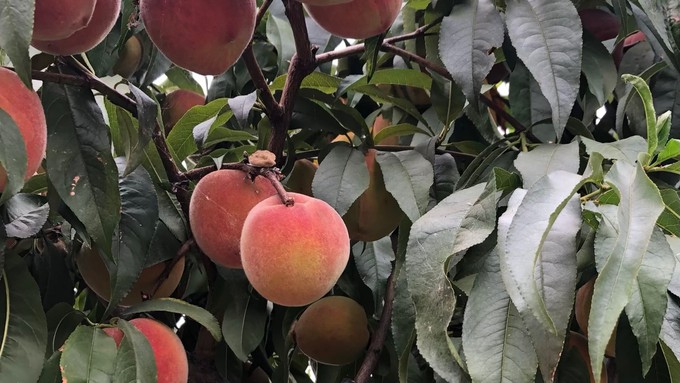
Learn about grafting and expand your orchard -- without growing new trees

If winter has you dreaming of peaches -- especially a new variety to graft onto an existing tree -- be sure to check out the Scion Exchange coming Feb. 26 in Carmichael. Kathy Morrison
Got fruit trees? Want more variety in your home orchard? Then, this fascinating and fun event is for you.
It’s the annual Scion Exchange (and it has nothing to do with old Toyotas). Hosted by the Sacramento Valley Chapter of California Rare Fruit Growers, the exchange is like a big community swap meet of fruiting wood. Scions are young shoots that can be grafted onto other trees or root stock.
Set for Sunday, Feb. 26, the exchange will be held at La Sierra Community Center, 5325 Engle Road, Carmichael. CRFG members get the first crack at selecting scions from 10 to 11 a.m. (and also sharing their own). Then, the exchange is open to the general public from 11 a.m. to 1 p.m.
Want to be an early bird? Anyone interested in joining the CRFG chapter can do so in advance of the event. Sign up here: https://crfg.org/home/join/.
For $5 admission, participants can select from dozens of varieties of deciduous fruit and nut trees from apples to walnuts. The assortment usually includes many heirloom varieties that are hard to find elsewhere.
Learn the basics of grafting, too, and how to add variety to your existing trees. Create a “fruit basket” tree with an assortment of plums, pluots and peaches on one trunk, or a “rainbow apple” tree that bears green, red and yellow fruit that ripens throughout the season instead of all at once. (Sorry, no citrus; just deciduous fruit and nuts are allowed at this exchange.)
What to bring? The organizers ask participants to bring exact change – $5 cash – and some supplies: Zippered plastic baggies (preferably 1 gallon size), masking or painter’s tape, a heavy marking pen (that way participants can label scions as they pick them up) plus a larger bag or backpack to put everything in.
Also, bring your wish list of varieties; you may be able to find them.
“We ask that you only take one or two scions from the varieties you want,” organizers say. “Be sure to wrap tape around those scions and label them! There will be a few vendors selling items and also tables with items that you can root: figs, berries, etc. There will be chairs available to sit but wear comfortable shoes to wander around the tables.”
Details: https://sacramentocrfg.org or email sacramento@crfg.org.
– Debbie Arrington
Comments
0 comments have been posted.Sacramento Digs Gardening to your inbox.
Food in My Back Yard Series
May 6: Maintain soil moisture with mulch for garden success
April 29: What's (already) wrong with my tomato plants?
April 22: Should you stock up on fertilizer? (Yes!)
April 15: Grow culinary herbs in containers
April 8: When to plant summer vegetables
April 1: Don't be fooled by these garden myths
March 25: Fertilizer tips: How to 'feed' your vegetables for healthy growth
March 18: Time to give vegetable seedlings some more space
March 11: Ways to win the fight against weeds
March 4: Potatoes from the garden
Feb. 25: Plant a fruit tree now -- for later
Feb. 18: How to squeeze more food into less space
Feb. 11: When to plant? Consider staggering your transplants
Feb. 4: Starting in seed starting
Sites We Like
Garden Checklist for week of May 4
Enjoy this spring weather – and get gardening!
* Plant, plant, plant! It’s prime planting season in the Sacramento area. Time to set out those tomato transplants along with peppers and eggplants. Pinch off any flowers on new transplants to make them concentrate on establishing roots instead of setting premature fruit.
* Direct-seed melons, cucumbers, summer squash, corn, radishes, pumpkins and annual herbs such as basil.
* Harvest cabbage, lettuce, peas and green onions.
* In the flower garden, direct-seed sunflowers, cosmos, salvia, zinnias, marigolds, celosia and asters. (You also can transplant seedlings for many of the same flowers.)
* Plant dahlia tubers. Other perennials to set out include verbena, coreopsis, coneflower and astilbe.
* Transplant petunias, marigolds and perennial flowers such as astilbe, columbine, coneflowers, coreopsis, dahlias, rudbeckia and verbena.
* Keep an eye out for slugs, snails, earwigs and aphids that want to dine on tender new growth.
* Feed summer bloomers with a balanced fertilizer.
* For continued bloom, cut off spent flowers on roses as well as other flowering plants.
* Add mulch to the garden to maintain moisture. Mulch also cuts down on weeds. But don’t let it mound around the stems or trunks of trees or shrubs. Leave about a 6-inch to 1-foot circle to avoid crown rot or other problems.